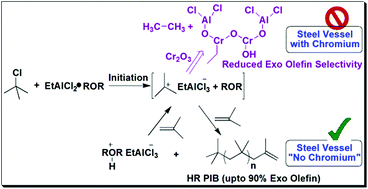Polymerization of isobutylene catalyzed by EtAlCl2/bis(2-chloroethyl) ether complex in steel vessels†
Abstract
When synthesis of highly reactive polyisobutylene (HR PIB) via cationic polymerization of isobutylene (IB) using ethylaluminum dichloride·bis(2-chloroethyl) ether (EADC·CEE) complex were carried out in metal reactors made of 316 stainless steel (SS), PIB olefin with up to 20% lower exo-olefin content were obtained compared to that obtained in glass reactors (up to 90%). In an effort to investigate this reduction in exo-olefin selectivity in SS reactors, we have studied the polymerization of IB using EADC·CEE complex in SS (minimum of 10.5% chromium content by mass), carbon steel (CS) (0% chromium content by mass), monel alloy 400 (M400) (0% chromium content by mass) and glass reactors. The latter was examined in the presence and absence of SS balls. Mechanistic studies using ATR-FTIR and 1H NMR spectroscopy suggest that this decrease in exo-olefin selectivity is due to a side reaction of EADC with Cr2O3 involving the loss of the ethyl group from EADC and decomplexation of the EADC·CEE complex which hinders the selective abstraction of the β-proton from the growing chain end. In the absence of chromium (CS and M400 reactors), the exo-olefin content is virtually identical to that obtained in glass reactors. Therefore, CS and M400 reactors are suitable to produce HR PIB with high exo-olefin content.


 Please wait while we load your content...
Please wait while we load your content...